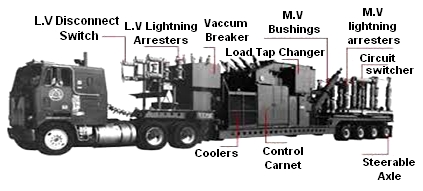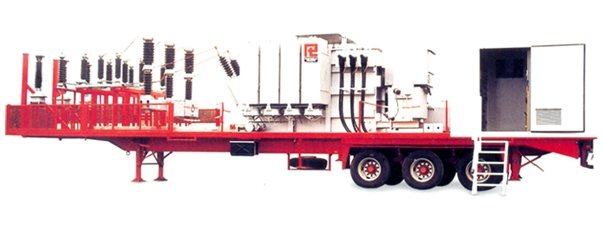The articles by our dear member Martin M. are pretty smart and the other members often agree with him. Let him tell you more about mobile substations, a topic he likes to write about.
Remember that you too can send us articles, we’d be glad to review then publish them. Just send a mail to the team.
The primary function, or purpose of a mobile substation is to provide temporary restoration to power supply through circumventing faulty or damaged low and medium voltage substation systems(up to 245kv) and equipment. Harsh weather conditions and natural disasters are usually the main cause of damage to substations.
The MS allows for the procurement of the required repair equipment, grid component, as well as reduced disruption to power supply.
Features
A mobile substation usually consists of a emergency/station power supply, switchgear, auxiliary service ac/dc high power density transformer and an enhanced cooling and monitoring system, all mounted on a reinforced trailer bed. Additional equipment includes mechanical lifts for levelling at the site.
Because the MS is on a trailer, there are primary features to minimize the weight and size. They include the following:
- Rotating transformer: this allows for easy placement under power line bushing without having to move the truck.
- Rotating circuit breakers
- Sidewall mounted bushings
- Rack out circuit breakers
- Light weight parts such as cabinets, tanks and cooling systems i.e. aluminium
- Use of high technology equipment such as telescopic parts, as well as standardization
- Factory testing for quick installation
Other features include:
- Dimensions to fit the state and federal regulations: In this regard, compactness is the primary consideration. The width of the trailer poses the greatest challenge due to the conflict between transport regulations and specifications, manoeuvrability, and electrical standards such as the minimum air clearance between live and earthed parts.
- Safety and environmental considerations: Do note that in some instances, the mobile substation is placed in public areas. The easiest way to achieve safety is minimum permitted electrical clearances and standardization to enable equipment interlocking.
- Reduced set-up time for effective attendance to emergency situations
- Ease of assembly and portability
This problem is usually overcome by using rack-out configurations for the equipment support. Modern substation technology such as GIS allow for compact systems, thereby eliminating the problem. Lastly, the container configuration allows for easy integration of a monitoring section, with a cut off local office for personnel.
Applications
The principal application of mobile substations is grid power restoration for critical infrastructure and facilities such as the communication industry, medical institutions, and re-establishing grid power to vital areas such as first responders and terrorism response units. The primary users of MS are power supply companies, both for outage repairs and planned maintenance, or temporary power demand increases.
Mobile substations are also in use during peak capacity increases. The system is put into use if a particular substation faces an increase in load that is not expected to last more than a few months. Such situation includes local construction projects and plant modifications where the demand will decrease once the project is completed. Rather than perform a permanent upgrade, the MS provides the required power for the duration.
MS are used to provide temporary power supply during unplanned repairs. This is most applicable in rural areas where the terrain does not allow for the redundancy of parallel circuits. Equipment failure at the substation can lead to supply problems, further leading to detrimental social and economic impacts.
Another primary application of MS is military bases, especially in cases involving deliberate attacks and sabotage. In instances of war and terrorism, it is important to ensure uninterrupted power supply so for effective response. This is more so when the back-up sources of power such as generators have been compromised through sabotage and attacks. Considering the fact that most substations are unmanned and remote, they are often the target of sabotage. In such instances, the mobile substations can provide power and mitigate prolonged disruptions.
As highlighted, mobile substations do provide immense benefits for the power supply and distribution companies. In most cases, the mobile substation is open for easy maintenance, as well as additional air insulation benefits.
However, harsh environmental and weather conditions such as saline conditions, snowy areas, as well as unfavourable atmospheric situations do compromise equipment performance. In such areas, containerized substations, similar to indoor GIS substations are used. The metal enclosure allows for easy transport, for example, to offshore locations where transport by sea in necessary.
Another benefit of containerised systems is the use in areas where there are variations on ground level.
Martin M.

